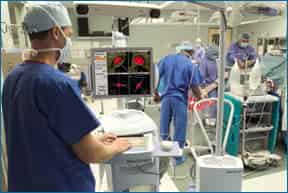Minimally Invasive Surgery (MIS), Computer Assisted Surgery (CAS), & Robotics

Hip replacement and knee replacement using minimally invasive surgery (MIS) methods with the assistance of computers and/or robotics is of keen interest to surgeons and patients. Improvements in technique and surgical instrumentation allow today’s surgeons to insert prosthetic hip and knee joints using shorter skin cuts with less surgical trauma, often resulting in fewer days spent in the hospital. These technologies are still relatively new and research is ongoing, so some surgeons aim to temper patient expectations, but patient demand and competitive pressures on surgeons mean that these techniques are being increasingly utilized.
Minimally Invasive Surgery (MIS)
Research in musculoskeletal science has brought about revolutionary changes in the ability to deliver high quality life-altering joint replacement procedures. Recent advances have introduced better bearing materials to reduce wear and greatly increase serviceable life. Recent trends have focused on improved rehabilitation and pain management to accelerate post-surgery recovery. Employing new surgical techniques to reduce the size of the incision and damage to underlying structures has been the primary advance toward this goal. These new techniques are known as MIS or Minimally Invasive Surgery.
While these improvements have a real theoretical advantage, there are several things to keep in mind. First, at 3 months following surgery, there seems to be no difference in the comfort and function of patients having conventional surgery and those having an MIS procedure. With limited visibility afforded to the surgeon, however, MIS techniques have a risk of increased complications including sub-optimal device placement. This can negatively impact the long term-success of the replacement as well as it’s short-term function.
More about MIS for Hip Replacement >>
More about MIS for Knee Replacement >>
Computer-Assisted Surgery & Robotics
Robotics: Through computer-assisted surgery, your surgeon obtains 3-D visualization allowing greater visibility, corrective alignment and balance of the implant joint.
Joint replacement surgery with the aid of a Navigation System helps improve the results of your procedure. The System empowers surgeons to accurately fit new implant components specifically to the anatomy of the body, potentially giving you:
- More exact implant placement
- Extended life of the implant
- Optimal joint positioning which restores mobility
- Decreased possibility of a revision surgery
- Faster recovery
- Improvement in your quality of life
Navigation: Advanced computer-assisted surgical solutions that greatly enhance the precision and accuracy of hip and knee replacement surgeries.
Think of a Navigational System as an assistant to surgery, providing your surgeon with extra support and guidance. The System helps your surgeon more precisely align your knee implant with computer imaging. Most importantly, with a Navigational System your surgeon is able to better optimize the implant’s alignment according to the structure of your body.
Computer-Assisted Surgery also facilitates Minimally Invasive Surgery (MIS) because it acts as an extension of the surgeon’s eyes and hands. It helps surgeons operate more effectively through a smaller incision.
Next Steps
Discuss these options with your surgeon, or use our Clinic Locator to find a orthopedic clinic in your area. We also invite you to visit our Patient Forum to discuss options and share experiences with our experienced moderators, and both pre-operative and post-operative patients.
Related Articles
- Minimally Invasive Hip & Knee Replacement Surgery Commentary (Dr. Jonathan P. Garino)
- A Surgeon’s Perspective: Minimally Invasive Hip & Knee Surgery (Dr. B. Sonny Bal)
Knee:
- Minimally Invasive Surgery (MIS) for Knee Replacement
- MIS Knee Procedures
- Computer-Assisted Robotic Knee Replacement Surgery
- Advantages of Minimally Invasive Surgery for Knee Replacement
- Why Computer Imaging May be Used Prior to Knee Replacement